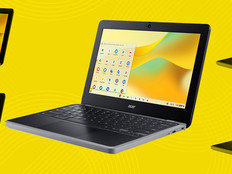What Is a Mimeograph Machine?
The mimeograph machine arrived about the same time as hot-metal typesetting, a process commonly used in newspaper publishing that involved melting metal into different character shapes. But the mimeograph effectively took the opposite approach.
Essentially, it was a stencil machine combined with an ink roller. Rather than using an additive process to make the necessary pages, the mimeograph relied on a master page, often made of wax, that had elements stenciled out. The ink was then forced through the holes in the master page, producing high-quality copies.
This approach also made it possible to create numerous copies on the fly for repeated use. And while the mimeograph was utilized for printing all sorts of documents, it became popular among schools and churches in particular because of its relatively low cost and ease of use.
Mimeograph machines shouldn’t be (but often are) mistaken for another technology widely used in classrooms of the time: the spirit duplicator or ditto machine. This machine used a similar crank-based process, but involved the use of alcohol-based solvents, which dissolved the ink from a master sheet and transferred it onto other pieces of paper. (Side note: This gave the resulting sheets quite the smell, as famously highlighted in the somewhat accurate 1982 documentary on high school life, Fast Times at Ridgemont High.)
Although spirit duplicators couldn’t be used once the solvents ran out, they were still inexpensive and easy to implement, similar to the mimeographs. As a result, both found common use in schools before the computer became prominent.
DISCOVER: Read about the K–12 schools that are using 3D printers to make a difference.
Who Invented the Mimeograph Machine?
While he can’t take full credit, Thomas Edison is partly credited with the invention of the mimeograph. The technology evolved from a series of similar devices over the span of a few decades, including the “electric pen,” which Edison developed in 1875 to produce stencils for repeated use.
Other technologies used for copying helped formulate some of the key concepts on which the mimeograph is based. One example is the hectograph, a common device in the 19th century that relies on transferring ink between multiple pages using a sheet of gelatin. While it could only make a handful of copies effectively, it was a useful tool for multicolor image duplication and has found modern uses in art and crafting.
But the most important invention that influenced the creation of the mimeograph is a device called the cyclostyle, which was developed by Hungarian-British inventor David Gestetner in 1887. The cyclostyle took the basic concepts of ink reproduction developed by the hectograph and Edison’s electric pen and tied them to a crank wheel, allowing for easy, inexpensive printing of documents from a stenciled page. While a flat-bed version slightly predated Gestetner’s version, the hand-crank was significantly faster.
This device solved a common problem for many printers throughout the 19th century. Often, it was ineffective to produce small runs of documents — think 20 to 50 copies, about what a classroom might use — with large printing machines used for books or newspapers. This meant that, before the mimeograph, such copies were produced by hand.
MORE ON EDTECH: Learn about the next-level printers of today.
Why Was the Mimeograph Such an Important Device for Education?
We often talk about how modern technology concepts such as automation save us time. In many ways, the mimeograph was ground zero for this, because it made possible the production of hundreds — even thousands — of document copies in a single sitting.
This made mimeographs popular for distributing document variants — such as worksheets and tests — in the classroom, which saved teachers valuable time. Rather than spending all day typing out numerous copies of the same exam, for example, teachers could just crank the wheel on a mimeograph for a little while. If it was an electric mimeograph, they just had to wait for it to complete the job.
Mimeographs also came in handy producing the school newspaper. The device provided an outlet for creativity that students took advantage of as they wrote about the world around them. A 1953 issue of Boys’ Life, the Boy Scouts of America’s monthly magazine, recommended that aspiring newshounds should work with their local schools and churches to gather tools for stenciling, such as light boxes.
While mimeographs were never as powerful as traditional offset printing processes, they filled an important gap for educators for decades. And even though they were quickly replaced by HP desktop printers and Xerox photocopying machines when prices dropped, mimeographs still supported document collaboration before it was easy.
Just don’t mistake them for spirit duplicators.
“This Old Tech” is an ongoing series about technologies of the past that had an impact. Have an idea for a technology we should feature? Please let us know!










